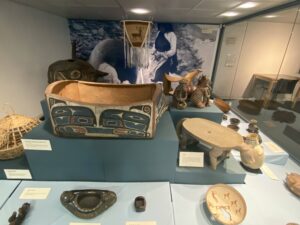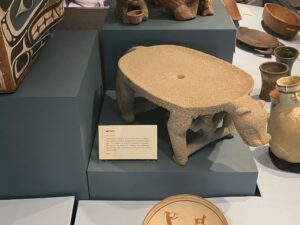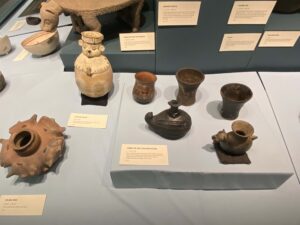Activity 7 – Foodways

Just as the environment affects what houses are built, what transportation options are useful, and how clothes need to function, it also has an important impact on what foods are available. Due to global interconnectedness and technology, many people today have access to food from a wide geographical area. In the past, however, food usually came from a rather small local area. People would have been very familiar with the various food options available to them, and would have spent much of their time hunting, gathering, growing, and preparing the food they needed. These activities – called subsistence practices – are very interesting to Anthropologists, who often study not only the foods people eat, but also the tools they use to acquire and prepare it. Cultures have had plenty of time to perfect their tools based on their common diet.

To the right is a metate, a large and slightly flat stone on which people would grind tough things like grains or cocoa using a second stone called a mano. Manos and metates were often used in some cultures in Central America to do things like turning maize into meal, which could then be mixed with water to make tortillas or other foods. In fact, many cultures around the world have a similar practice in which a grain is ground, mixed with water, and cooked into a flat breads. Besides tortillas, there are chepati, focaccia, lavash, matzah, naan, pitas, roti, and the list continues! These breads are not only nutritious, they are convenient edible food containers or utensils.

In the picture to the left you can see a group of five Peruvian vessels (on the right). Three of these either show or are shaped like food items, and two are specialized vessels for a specific food. (Don’t forget, click on the picture to see a larger version, and click on the links in the caption to see entries for each item in our Online Collections.) In the upper left of the group is a Nasca vessel that shows both aji peppers and lima beans. These, along with the squash depicted by the spouted jar in the front, were common crops on this region. The two vessels with the flared rims in the upper right are called “keros” and were used as drinking cups for chicha, or corn beer. Corn, beans, squash, and chili peppers are all native to the Americas. The spouted vessel in the lower right is shaped like a capybara – a large rodent native to South America. It is similar to a guinea pig, but is a common food animal in that region – a clear demonstration that different cultures think differently about what is food!
A lot changed after Europeans and the Native peoples of the Americas made contact. Many indigenous foods were carried back to Europe and have become familiar staples in our favorite foods today. For example, think about Italy and spaghetti – the noodles actually originated in China, not Italy, and tomatoes came from South America! And it’s not a one-way street, either. When you think about tacos, do you think of beef? Or chicken? Both of these animals were common in Europe, but not found in the Americas until after significant trade and colonization occurred. Original tacos might have had turkey, capybara, or even dog in them! A lot of food is like that, a mix of ingredients from all over the globe!
Activity Time!
Think about some produce and animals you probably see or interact with a lot; which continents do you think they originally came from? Flip to the Foodways section, and guess where the animals and produce below came from! Click here for the answers when you’re done and see how many you got right!
Produce: Animals:
Apples Llamas
Pumpkins Caribou
Squash Horses
Potatoes Deer
Carrots Dogs
Watermelons Beaver
Grapes Bison
Coconut Sheep
Yams Turkey
Corn Cows
